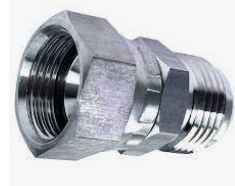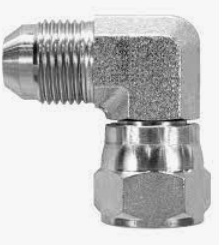Proper fitting measurement is a critical aspect of fluid conveyance systems. In the world of hydraulic and pneumatic connections, precision is paramount. JIC fittings are important for making sure connections are reliable and don’t leak.
In this guide, we explain why it’s important to measure JIC fittings accurately. This ensures a perfect fit every time.
What Are JIC Fittings?
JIC 37° Swivel Fittings Swivel Extender Male JIC / Female JIC Swivel 90°
JIC fittings are known for being reliable and easy to use in hydraulic and pneumatic systems. They are commonly used in high-pressure systems, offering a secure and leak-free connection.
Common Applications
JIC fittings are used in many industries, like aerospace, automotive, and industrial machinery. They are the preferred choice where reliable fluid conveyance is essential.
The Role of JIC Fittings in Fluid Conveyance
JIC fittings help fluids flow smoothly in hydraulic and pneumatic systems to prevent leaks.
The Anatomy of JIC Fittings
Components of JIC Fittings
➡️ JIC fittings have different parts: a threaded connector, a body, a sleeve, and a nut. Understanding the role of each component is vital for precise measurement.
Threads and Sealing Mechanisms
➡️ JIC fittings rely on threads for securing connections and O-rings for sealing. The precision of thread measurement is crucial to achieve a reliable seal.
Importance of Precision Engineering
➡️ JIC fittings are famous for their precise engineering. This ensures connections that are consistent and don’t leak. Accurate measurement ensures that this engineering is put to good use.
Tools Required for Measuring JIC Fittings
Calipers and Micrometers
➡️ Precise measurement tools like calipers and micrometers are indispensable for determining dimensions accurately.
Thread Gauges
➡️ Thread gauges are used to identify thread size, pitch, and type, ensuring a compatible fit.
Sizing Charts and Reference Guides
➡️ You can find information about JIC fitting sizes and details in charts and guides.
Step-by-Step Guide to Measuring JIC Fittings
Measuring Thread Size
➡️ Accurate measurement of thread size is the first step in ensuring a proper fit. This involves determining the diameter and pitch of the threads.
Determining Thread Type
➡️ To choose the right fittings, it’s important to know the thread type (like UNF or NPT). This ensures compatibility.
Measuring Thread Angle
➡️ To make sure the connection is secure, you need to accurately measure the thread angle. JIC fittings usually have a thread angle of 37 degrees.
Considerations for Flared Fittings
Measuring Flare Angle
➡️ To ensure the flare fittings work properly, it’s important to measure the flare angle accurately. This helps make sure the cone is positioned correctly and the seal is tight.
Flare Diameter Measurement
➡️ To make sure the parts fit together perfectly, it’s important to measure the flare diameter.
Ensuring Leak-Free Sealing
➡️ To prevent fluid leakage, make sure to measure flared fittings accurately for a leak-free seal.
Measuring O-Ring Fittings
Identifying O-Ring Size
➡️ Measuring the O-ring size is essential to ensure compatibility and sealing effectiveness.
Ensuring Proper O-Ring Compatibility
➡️ To prevent leaks, it is important to check if the O-ring size matches the fitting’s requirements.
Verifying O-Ring Cross-Section
➡️ To ensure a tight seal, it’s crucial to accurately measure the cross-section of the O-ring.
Troubleshooting and Common Measurement Errors
Identifying Common Measurement Mistakes
➡️ Recognizing and addressing common measurement errors is crucial for achieving accurate results.
Tips for Accurate Measurement
➡️ Utilizing the right tools, practicing precision, and double-checking measurements can significantly reduce errors.
Seek Professional Help When in Doubt
➡️ If you need help with complicated fittings, it’s best to get professional assistance. This will make sure everything is accurate and reliable.
Application of Measured Data
Ordering the Right JIC Fittings
➡️ Choosing the right JIC fittings is important. Accurate measurements help prevent expensive mistakes and system downtime.
Achieving Leak-Free Connections
➡️ Precise measurement is the key to achieving leak-free connections, enhancing system reliability.
Enhancing System Reliability
➡️ Accurate measurement helps fluid systems work well and be reliable.
Common Questions About JIC Fittings
Q: How Do I Know if My Fitting is JIC?
A: Identifying a JIC fitting is easy once you recognize the distinctive 37-degree flare. Additionally, JIC fittings often have markings indicating their size and specifications. Make sure to look for these marks to make sure you use the right fitting in your hydraulic system.
Q: What Size Thread Does a JIC Fitting Have?
A: JIC fittings come in various sizes, ranging from 1/8 inch to 2 inches in diameter. To determine the thread size, follow the measurement steps mentioned earlier. Refer to a reliable thread size chart to find the exact specifications of the fitting you are working with.
Conclusion
The art of measuring JIC fittings is a crucial aspect of fluid conveyance systems. Making sure that every connection fits perfectly is not just about stopping leaks. It’s also about ensuring that hydraulic and pneumatic connections are reliable and strong. Accurate fitting measurement is important. It helps industries achieve seamless fluid conveyance and optimal performance.
Post time: Nov-29-2023



